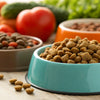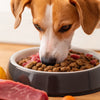How to Get My Dog to Eat Kibble Again: Tips and Strategies for Picky Eaters
- Houndsy
Table of Contents
- Introduction
- Understanding Why Your Dog Won’t Eat Kibble
- Strategies to Encourage Your Dog to Eat Kibble Again
- Enhancing the Feeding Experience with Houndsy
- Conclusion
Introduction
As devoted dog owners, we know the joy of watching our furry friends chow down on their favorite meals. But what happens when our beloved pups suddenly turn their noses up at their kibble? It's a scenario that can leave us feeling concerned and frustrated. Did you know that nearly 20% of dogs experience a change in appetite at some point in their lives? This can be attributed to various factors, from health issues to simple pickiness.
Understanding why our dogs may refuse to eat kibble is crucial for their overall well-being. In this blog post, we'll explore the reasons behind a dog's aversion to kibble, practical tips for encouraging them to eat again, and how our innovative Houndsy Kibble Dispenser can enhance their feeding experience.
By the end of this article, you will have a comprehensive toolkit for tackling your dog's food refusal, ensuring mealtimes are both enjoyable and healthy. We'll also discuss how our commitment to design excellence and pet well-being at Houndsy aligns with creating a feeding environment that nurtures healthy habits. So, let’s dive into the world of dog feeding and discover how we can get our dogs to eat kibble again.
Understanding Why Your Dog Won’t Eat Kibble
Before we can effectively address a dog's refusal to eat, it’s essential to understand the potential reasons behind this behavior. Here are some common factors that might contribute to your dog's pickiness:
1. Health Issues
Health problems are often the first thing to consider when a dog stops eating. Conditions such as dental disease, gastrointestinal issues, or infections can lead to a decreased appetite. If your dog shows other symptoms like vomiting, lethargy, or changes in behavior, it’s crucial to consult your veterinarian.
2. Food Quality and Expiration
The quality of the kibble can significantly affect a dog's willingness to eat. If the food has expired or is of poor quality, your dog may simply find it unappetizing. Regularly check the expiration date on your dog’s food and ensure it is stored properly to maintain freshness.
3. Environmental Changes
Dogs are creatures of habit, and any changes in their environment—such as moving to a new home, changes in family dynamics, or even rearranging their feeding area—can impact their eating habits. Stress or anxiety from these changes may lead to a refusal to eat.
4. Picky Eating Behavior
Just like us, some dogs can be picky eaters. If they are used to receiving table scraps or a variety of flavors, they may turn their noses up at plain kibble. This behavior can also develop if dogs are allowed to graze or are fed at irregular times.
5. Kibble Fatigue
Kibble fatigue is a real phenomenon. It occurs when dogs become bored with the same food day in and day out. If your dog has been eating the same brand or flavor of kibble for an extended period, they may simply lose interest.
6. Bowl Issues
Sometimes the problem can be as simple as their food bowl. If the bowl is too small, difficult to access, or unclean, it can discourage a dog from eating.
Strategies to Encourage Your Dog to Eat Kibble Again
Now that we understand potential reasons behind your dog's refusal to eat kibble, let's explore actionable strategies to entice them back to their bowl.
1. Consult Your Veterinarian
The first step is to rule out any medical issues. A visit to the vet can help identify underlying health problems that may be causing your dog to avoid their food.
2. Assess Food Quality
Ensure that you are using high-quality kibble. At Houndsy, we believe in premium ingredients that not only provide nutrition but also ensure that our dogs find their meals appetizing. If your dog isn’t responding to their current kibble, consider switching to a brand that uses natural ingredients and offers a variety of flavors.
3. Introduce Tasty Toppers
One effective way to make kibble more appealing is to add toppers. Healthy options include:
- Bone broth: A savory addition that enhances flavor.
- Pumpkin puree: Rich in fiber and great for digestion.
- Cooked vegetables: Carrots, peas, and green beans can add texture and taste.
4. Change Feeding Environment
Evaluate where and how you feed your dog. If your dog eats better in a quiet, stress-free area, consider moving their bowl to a different location. Ensure the bowl is clean and appropriate for their size.
5. Warm the Kibble
Warming kibble slightly can enhance its aroma, making it more enticing. Just be sure it's not too hot, as dogs can be sensitive to temperature.
6. Adjust Feeding Schedule
Establishing a consistent feeding schedule can help regulate your dog’s appetite. Offer food at the same times each day and remove uneaten food after 15-20 minutes. This approach can help prevent grazing and encourage your dog to eat when food is presented.
7. Use Puzzle Feeders
Introducing a puzzle feeder can make mealtime more engaging. These interactive feeders turn eating into a fun activity, stimulating your dog’s mind while encouraging them to eat.
8. Gradual Transition to New Foods
If you’re switching kibble brands or flavors, do so gradually. Mixing the new food with the current kibble over several days can help ease the transition.
9. Limit Treats
To increase your dog’s motivation to eat kibble, reduce the number of treats they receive. This will ensure they are more inclined to eat their meals when offered.
10. Promote Hydration
Sometimes dogs may refuse to eat kibble if they are not adequately hydrated. Ensure your dog has access to fresh water at all times, and consider adding water to their kibble to make it more palatable.
Enhancing the Feeding Experience with Houndsy
At Houndsy, we understand the importance of a pleasant feeding experience for both pets and their owners. Our flagship product, the Houndsy Kibble Dispenser, combines form and function, allowing you to serve kibble conveniently and stylishly.
Features of the Houndsy Kibble Dispenser
- Perfect Portion Control: Our dispenser delivers precise portions every time, which helps manage your dog’s diet effectively.
- Ergonomic Design: The standing height crank eliminates the need for bending, making feeding easier for us and more comfortable for our dogs.
- Large Storage Capacity: With a capacity of 25-30 lbs, it reduces the frequency of refills and keeps kibble fresh with a BPA-free liner.
- Auto-Locking Mechanism: This feature prevents accidental dispensing by curious pets or toddlers, ensuring that feeding time is safe and stress-free.
By incorporating the Houndsy Kibble Dispenser into your dog's feeding routine, you can help create a more inviting environment that encourages them to eat their kibble.
Conclusion
When our dogs refuse to eat kibble, it can be a source of worry, but understanding the underlying reasons and implementing practical strategies can help. From addressing health concerns to enhancing the feeding experience with our innovative Houndsy Kibble Dispenser, we can make mealtime enjoyable for our furry friends once again.
If you're looking to elevate your dog’s feeding experience, consider exploring the Houndsy Kibble Dispenser today. Together, we can ensure our dogs are happy, healthy, and eager to eat their kibble again.
Frequently Asked Questions
1. How long can a dog go without eating before it becomes serious?
Most dogs can go without food for about 1-3 days without significant health risks, but it's crucial to consult a veterinarian if your dog refuses to eat for more than 24 hours, especially if they display other concerning symptoms.
2. What should I do if my dog continues to refuse kibble after trying these tips?
If your dog continues to refuse kibble despite implementing various strategies, it’s important to consult your veterinarian for further evaluation. There may be underlying health issues that need to be addressed.
3. Can I mix wet food with kibble to encourage my dog to eat?
Yes, mixing wet food with kibble can make it more appetizing and encourage your dog to eat. Just be sure to gradually transition between different food types to avoid digestive upset.
4. Is it normal for dogs to have occasional changes in appetite?
Yes, it is normal for dogs to experience fluctuations in appetite due to various factors, including stress, changes in routine, or seasonal shifts. However, significant or sudden changes should be monitored closely.
5. How can I improve my dog's overall eating habits?
To improve your dog’s eating habits, establish a consistent feeding routine, limit treats, and create an inviting feeding environment. Consider using high-quality food and engaging feeding methods to make mealtime enjoyable.
By implementing these strategies, we can help our beloved pets return to their joyful eating habits, ensuring they receive the nutrition they need to thrive.













